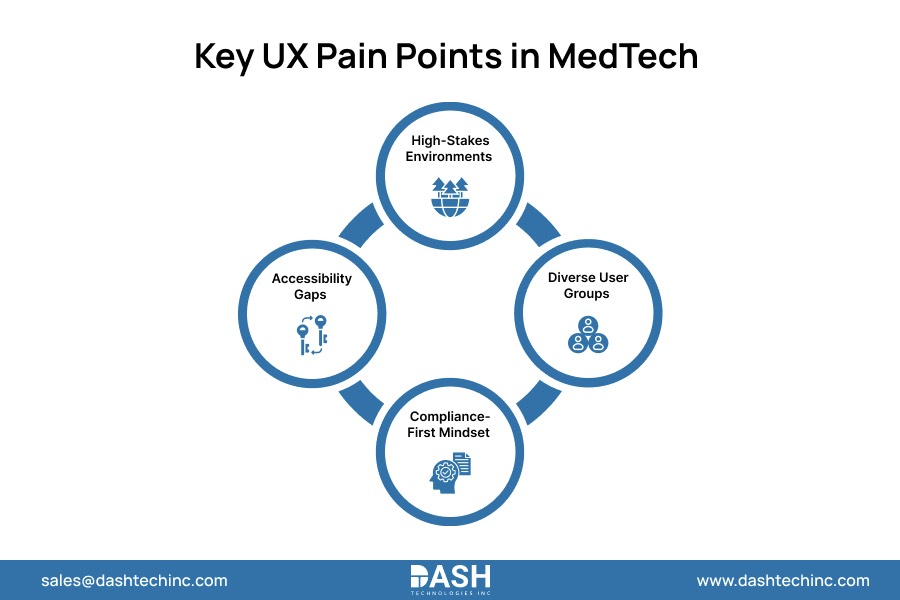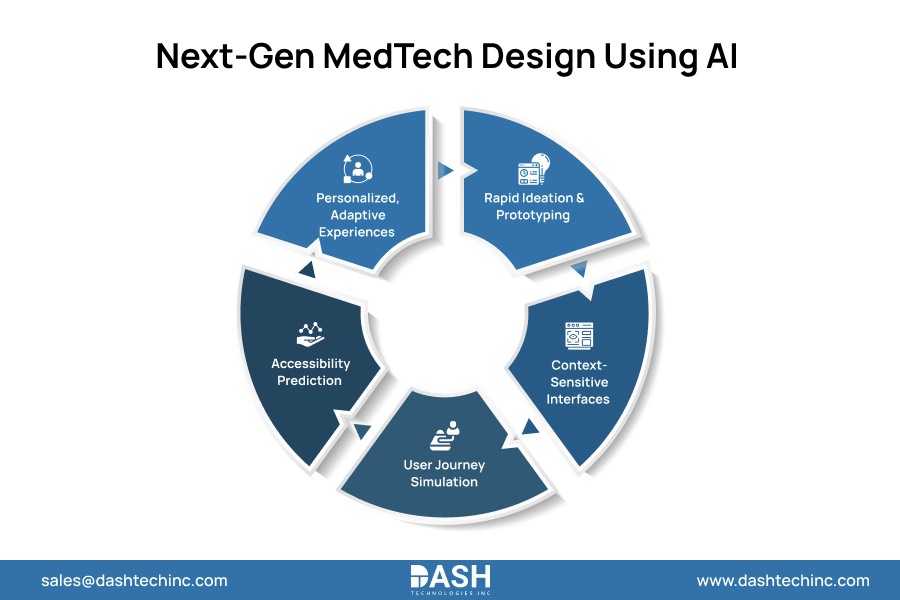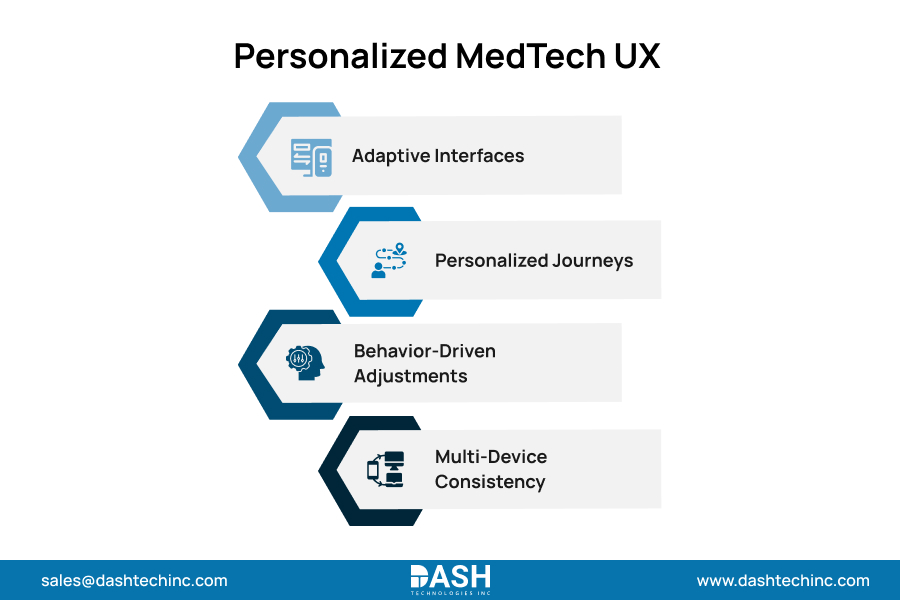Generative AI for MedTech Product Design and UX Personalization
Introduction
In healthcare, there’s much more at stake with design decisions than in many other industries. Each button press, display and workflow can have immediate consequences for patient safety, clinical effectiveness, and end results. A mispositioned field in an e-commerce app may lead to customer frustration, but in the hospital, it could cause life-saving care to be delayed.
For all of that, however, many MedTech applications today are hobbled with clumsy dashboards, stiff workflows and one-size-fits-all design. Clinicians waste hours dealing with cumbersome user interfaces, patients give up on apps that seem too complex and health care organizations spend tens of millions of dollars for tools that hardly anyone ever uses.
The solution lies in AI for MedTech product design—leveraging generative AI to create user-centered, adaptive, and accessible experiences while maintaining regulatory compliance.
Common UX Challenges in MedTech

- High-Stakes Environments
In emergency rooms or on the operating table, time is critical. Design fails when experts must click through seven screens to access what they need. Every interaction should be efficient, intuitive, and clear.
- Diverse User Groups
Healthcare applications serve a wide range of users—doctors, nurses, patients, administrators, and insurers. Each has different needs, yet most apps offer one rigid interface. Consistency is important, but when it comes to the expense of usability, the system ends up hampering users instead of helping them.
- Compliance-First Mindset
HIPAA, FDA, and GDPR are non-negotiable. However, when compliance overrides design, usability often suffers. Many apps check regulatory boxes but fail to provide a seamless user experience.
- Accessibility Gaps
Patients may be elderly, disabled, or have low digital literacy. Without equitable design, mobile health apps risk alienating the very users who need them most, exacerbating disparities in care.
Harnessing AI for Smarter MedTech Design

Generative design, powered by artificial intelligence (AI) and machine learning (ML), enables designers to leverage computational capabilities to explore new forms of expression and functionality in MedTech applications.
Design teams are increasingly structured around generative AI workflows. Tasks that previously took weeks to produce multiple potential models can now be completed in hours, enabling faster iteration and deeper exploration of design possibilities.
Key Capabilities of Generative AI
- Rapid Ideation and Prototyping: Generate multiple design variations and user flows for comparison and evaluation.
- Context-Sensitive Interfaces: Adapt displays dynamically according to user role, time, or care environment.
- User Journey Simulation: Model and stress-test pathways for patients, clinicians, and administrators.
- Accessibility Prediction: Anticipate barriers for users with low vision, motor disabilities, color blindness, and more, addressing issues before deployment.
Example: Patient apps that personalize reminders based on medical history or clinician dashboards that surface key data during shifts are becoming standard with AI for MedTech product design.
Accelerating MedTech Innovation
GenAI offers the ability to rapidly generate high-quality ideas for medical device product design, accelerating innovation and enhancing user-centered outcomes.
- Rapid Prototyping
Traditional design cycles can take weeks to wireframe concepts and obtain stakeholder approval. With AI, teams can produce multiple design iterations within hours, prototyping incrementally and freeing human designers to focus on empathetic, user-focused refinements. - Context-Responsive Experiences
Healthcare processes vary significantly across different settings. A critical care nurse may need quick access to vital and medication alerts, while an outpatient clinic nurse prioritizes scheduling and patient follow-ups. Generative AI enables interfaces to adapt seamlessly to varying roles and care environments, improving usability and workflow efficiency. - Inclusive by Default
AI tools can anticipate accessibility barriers before a design is finalized. Designers can virtually simulate experiences for patients with color blindness, low vision, or other impairments, ensuring that accessibility is integrated from the outset rather than added later.
Intelligent UX Personalization

AI is transforming healthcare user experiences by tailoring interfaces and interactions to individual users—both clinicians and patients.
- Adaptive Interfaces for Clinicians
AI customizes dashboards for different roles: surgeons see imaging data prominently, E.R. physicians prioritize triage status, and nurses access medication schedules instantly. - Personalized Patient Journeys
Apps can adjust to patient conditions, e.g., diabetes management apps track blood sugar trends, while post-surgical recovery apps follow healing milestones and tasks, enhancing adherence. - Behavior-Driven Adjustments
AI monitors usage patterns and minimizes friction. For instance, if a patient repeatedly misses recording medications, the system can provide prompts or streamline workflows to improve compliance. - Seamless Multi-Device Consistency
AI-powered systems automatically adjust layouts across smartphones, tablets, and desktops, maintaining a consistent and intuitive experience.
Human + AI Collaboration
Generative AI is not a replacement for human creativity—it is a collaborator.
Human Designers Bring: Empathy, insight, ethical reasoning, and deep understanding of healthcare workflows.
AI Adds: Speed, scalability, and context-sensitive intelligence derived from data insights.
This collaboration ensures that patient focus, ethics, and inclusivity remain central, while enabling accelerated innovation in MedTech solutions.
Designing the Future of MedTech
The next generation of healthcare solutions will be judged not only by compliance or functionality but also by adaptability, accessibility, and personalization. AI for MedTech product design empowers teams to create solutions aligned with real-world clinical care and patient needs.
By combining human empathy with AI’s adaptive capabilities, MedTech can evolve from static systems into platforms that elevate care experiences.
A Final Word
AI for MedTech Product Design is reshaping HealthTech, enabling rapid prototyping, context-aware interfaces, and highly personalized experiences for clinicians and patients. It allows designers to focus on what truly matters: improving outcomes and humanizing digital healthcare.
Organizations adopting this approach will lead the future of healthcare, proving that great design goes beyond usability—it drives better health.
Ideas or questions? Let’s connect! Contact us now.
About Dash

Dash Technologies Inc.
We’re technology experts with a passion for bringing concepts to life. By leveraging a unique, consultative process and an agile development approach, we translate business challenges into technology solutions Get in touch.









